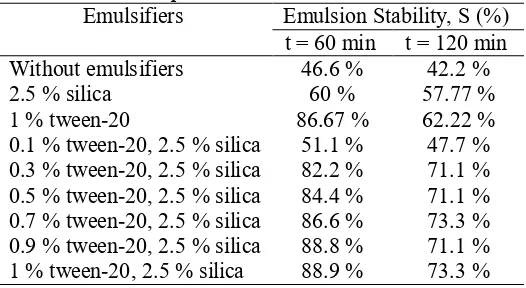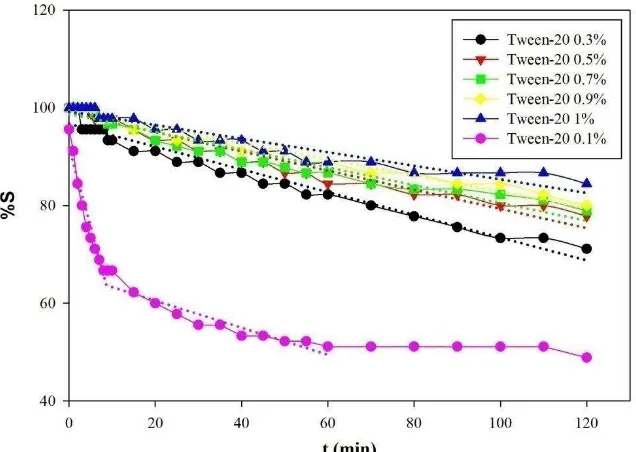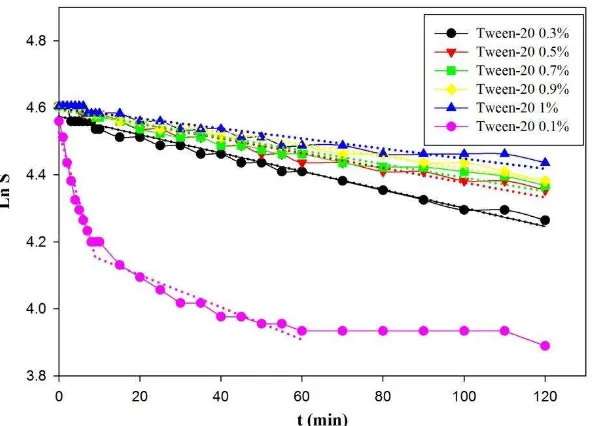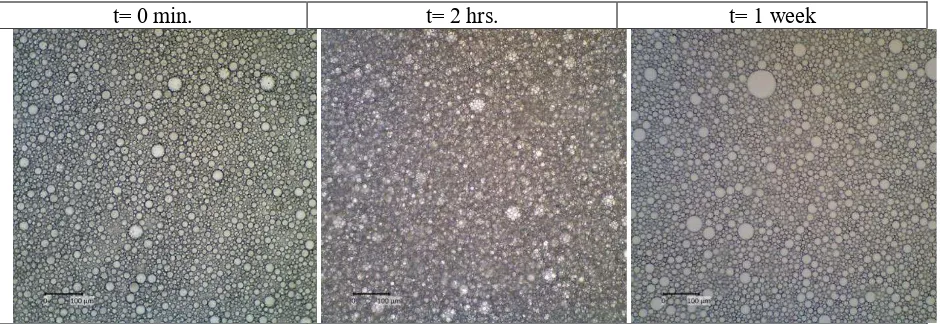PAPER • OPEN ACCESS
The effect of different concentrations of tween-20
combined with rice husk silica on the stability of
o/w emulsion: A kinetic study
To cite this article: L Sapei et al 2017 IOP Conf. Ser.: Mater. Sci. Eng. 273 012023
View the article online for updates and enhancements.
Related content
Crystallization process of a biomaterial, the lithium disilicate, obtained from rice husk silica
F A Santos, M H F V Fernandes, E Davim et al.
-Fabrication of Silica Glass from Rice Husk Ash with Spodumene Additions
T Wasanapiarnpong, B Vorajesdarom, E Rujirakamort et al.
-Upgrading of bio-oil from the pyrolysis of biomass over the rice husk ash catalysts
B Sutrisno and A Hidayat
The effect of different concentrations of tween-20 combined
with rice husk silica on the stability of o/w emulsion: A kinetic
study
L Sapei1, I G Y H Sandy1, I M K D Suputra1 and M Ray2
1
Department of Chemical Engineering, University of Surabaya, Raya Kalirungkut, Surabaya 60293 East Java, Indonesia.
2
POS Bio-Sciences, John and Charlotte Cross, BioSciences Centre, 118 Veterinary Road, Saskatoon, SK, S7N 2R4, Canada
E-mail: [email protected]
Abstract. Emulsion is a thermodynamically unstable system which undergoes destabilization
with time. The destabilization kinetics of “food grade” oil-in-water (O/W) emulsions in the presence of both tween-20 and rice husk silica as emulsifiers were studied. Rice husk silica concentration of 2.5% was combined with various concentrations of tween-20 from 0.1 to 1%. Oil phase fraction was 20% relative to the aqueous phase. Emulsification was conducted using a rotor-stator homogenizer at 20,000 rpm. The emulsions tended to destabilize with time. Their destabilization rates were studied using zero order and first order kinetic models. In general, the kinetics of O/W emulsion destabilization followed first order model. Different concentrations of tween-20 combined with rice husk silica influenced the destabilization rate of o/w emulsions. Destabilization rates of emulsions stabilized using mixed emulsifiers of 1% tween-20 and 2.5% silica were ~50 times and ~3 times lower compared to those stabilized using silica alone and tween-20 alone, respectively.
1. Introduction
Emulsion is a colloidal dispersion whereby dispersed phase and dispersion phase are immiscible. In order to form a stable system, emulsifiers have to be added. Emulsifiers could be natural or synthetics and many are found in foods, such as ice cream, whipped cream, margarine, chocolate, and so on. The synthetic ones could cause obesity [1], thus there have been many attempts to limit or reduce their use. Natural emulsifiers have low toxicity level, easily biodegraded, and do not cause obesity in the long term thus very suitable to be used in the food industries replacing the synthetic ones [2]. Amphiphilic polymers such as gum, polysaccharide, saponin, lecithin, lipoprotein, and solid particles such as silica have been generally used as emulsifiers. Emulsifiers used in this experiment was Tween-20 which was regarded as GRAS (generally recognized as safe) within the limited use and acceptable daily intake and amorphous biosilica isolated from rice husk. Rice husks are a natural reservoir for nanostructured silica which contain as much as ~20% silica of the dry weight of the rice husk [3]. Moreover, the silica within rice husks naturally exists in the form of nanoparticles with primary particles of ca. 4.2 nm in diameter [4].
2
were also easily detached from the interface thus destabilization occurred. Silica particles were difficult to be adsorbed in the interface of oil-water, but once being adsorbed; they stayed and stabilized the system [5]. Therefore, mixtures of amphiphilic polymer and solid particles were used to have a synergism effect [6]. Polymeric emulsifier was attached on the surrounding surface of oil-water interface while reducing the surface tension between two phases and solid particle formed the barrier on the oil globule surfaces thus preventing recoalescence which would lead to oil globule separation [6]. Emulsifier mixtures could reduce the rate of o/w emulsion destabilization.
Coalescence is the merging of smaller oil globules into bigger ones. In general, coalescence process which leads to o/w emulsion destabilization followed the first order kinetic model [7]. By investigating the kinetics of emulsion destabilization, the effect of mixed emulsifiers’ concentrations on the emulsion stability could be well investigated. This research was expected to give the beneficial contribution to the food industries dealing with development of a more healthful food emulsions for the determination of product shelf-life and storage condition. The aim of this research is to study the stabilization of o/w emulsion using mixture of various concentration of Tween-20 combined with rice husk silica for the formulation of food grade o/w emulsion with kinetics approach.
2. Materials and methods
Clean and dried rice husks were leached out using citric acid 5% in an agitated flask for the metallic impurities removal. Afterwards, they were rinsed several times using demineralized water and then dried in an oven (Memmert, Germany) at 105oC for 2 hours. Leached dried rice husks were then thermally treated in a furnace (Ney VULCAN D-550, Dentsply Ceramco, USA) at 750oC for 5 hours. White ashes consisting of almost pure silica (> 95%) were obtained after the thermal process. The rice husk silica were milled and screened. Biosilica of 200 mesh were used as the emulsifier of o/w emulsions. Biosilica is amorphous and inherently nanostructured with primary spherical particle of several nm in diameter [4].
2.3 Preparation of o/w emulsion stabilized with tween-20 and rice husk silica mixtures.
appearance with the formation of neither cream nor silica particles sediment. The emulsion stability
Whereas htis emulsion height at a certain time andh0is initial emulsion height.
2.5 Determination of kinetic models of destabilization rate of o/w emulsion.
The data used for the kinetic models determination was within 0-120 minutes, since the emulsion stability remained more or less constant after 120 minutes. The destabilization rate of o/w emulsion was fitted using the zero order or first order kinetic models. The most appropriate kinetic order would be chosen based on the best obtained correlation coefficient (R2) calculated using the least square procedure. The destabilization rate of the emulsion could be written in an equation as follows [8]:
a
the rate of emulsion destabilization, a the order of emulsion destabilization rate,
k
0 and k1the emulsion destabilization rate constants for the zero order (% stability/ minute) and for the first order (per minute), respectively, t the storage time (minute), the percentage of emulsion stability after time t and
S
0 the initial emulsion stability percentage.3. Results and discussion
Oil-in-water (o/w) emulsion is thermodynamically an unstable system, thus it tends to destabilize with time. However, the kinetic stability of the emulsion could be improved by the addition of emulsifiers. In these experiments, oil-in-water food emulsions were stabilized using combination of 2.5% of biosilica with various concentrations of tween-20 ranging from 0.1-1%. The concentration of 2.5% silica was selected based on our best preliminary results. Upon emulsifiers’ addition, the destabilization rate of the emulsion would be slowed down as the emulsion stability was increased. In these experiments, the emulsion destabilization was observed within 2 hours. The initial emulsion at t=0 had a milky appearance and seemed to be fully stable. In general, the formations of both cream layers on the top and silica sediments at the bottom became obvious after 1 hour till 2 hours. The estimated emulsions stabilities stabilized using various mixture of tween-20 and rice husk silica after 60 minutes and 120 minutes of observation could be seen in Table 1.
Table 1. Comparisons of % emulsion stabilities.
4
It could be seen that the emulsion stability was the highest both in short term (60 min) and long term period (120 min) when mixture of 1% tween-20 was combined with 2.5% silica. The addition of tween-20 only could achieve quite high short-term emulsion stability but after 1 hour, the stability dropped. The use of biosilica as a single emulsifier was also not efficient. The use of mixture biosilica and tween helped increase the emulsion stability both in the short-term and also in the long-term period. The polymeric emulsifier such as tween-20 was easily adsorbed at the interface between oil droplets and aqueous phase lowering the surface tension, but then it was also easily leached out from the interface with time. On the other hand, the use of biosilica only was not efficient since the biosilica was not easily adsorbed at the interface but once it stayed at the interface it would act as a barrier and stabilized the system [4]. Thereby, the synergism was achieved when mixtures of biosilica and tween-20 were used. Tween-tween-20 was initially adsorbed at the interface facilitating the adherence of biosilica particles thus protecting the overall droplets and reducing the droplets coalescences.
The emulsion stability was also studied using the zero order and first order kinetics models. The emulsion destabilization rate constants were the slopes of the graphs as could be seen in Fig. 1 and Fig. 2 for the zero order and first order models, respectively. The samples prepared with no emulsifiers and with single emulsifier were excluded from the figures since they showed several slopes. The kinetic rates were calculated by averaging the slopes. The overall kinetics data could be seen in Table 2. In general, emulsion stability was increasing with the increased concentration of tween-20. The tween-20 concentration of 0.1% seemed to be too low and insufficient to stabilize the emulsion.
Figure 2. Logarithmic of Emulsion Stability vs. time. Emulsions were prepared using 2.5% silica with variations of tween-20 concentrations. The dotted line represented the first order model.
Table 2. Kinetic emulsion destabilizing rates constants and R2 values according to zero-order and first order kinetic models of o/w emulsions stabilized using 2.5% silica and various Tween-20
concentrations.
Emulsifiers Orde 0 Orde 1
k0 (% stability/min) R 2
k1 (min -1
) R2
Without emulsifiers 4.9621 0.9235 0.0725 0.9434
2.5 % silica 5.7525 0.7749 0.0724 0.7937
1 % tween-20 0.3524 0.9460 0.0040 0.9540
0.1 % tween-20, 2.5 % silica 1.7681 0.9119 0.0231 0.9321
0.3 % tween-20, 2.5 % silica 0.2326 0.9634 0.0027 0.9769
0.5 % tween-20, 2.5 % silica 0.1962 0.9586 0.0022 0.9690
0.7 % tween-20, 2.5 % silica 0.1824 0.9447 0.0020 0.9568
0.9 % tween-20, 2.5 % silica 0.1660 0.9722 0.0018 0.9788
1 % tween-20, 2.5 % silica 0.1390 0.9349 0.0015 0.9422
The kinetics data as could be seen in Table 2 proved that the increasing concentration of tween-20 resulted in the decreasing value of the emulsion destabilization rate constant indicating the higher stability of the resulting o/w emulsions. Moreover, the destabilization kinetic of o/w emulsion more fitted to the first order compared to the zero order based on the R2 values. The most stable emulsion with the lowest k1 of 0.0015 min
-1
6
synergism of silica particle and tween-20 in stabilizing the oil droplet dispersions in the aqueous phase. The Pickering emulsion was expected to be more stable in the long-term period especially for food applications. However, the droplets tended to get bigger with time as could be seen in Fig. 3 due to the inherent instability of the emulsion. This could be mainly due to the coalescence of oil droplets due to the desorption of either tween-20 or silica from the interface which followed the first order kinetic model [7].
t= 0 min. t= 2 hrs. t= 1 week
Figure 3. The microscopic images of o/w emulsion stabilized using combined 2.5% rice husk silica and 1% Tween-20 during storage at room temperature (~28oC).
4. Conclusions
The use of combined silica particles and tween-20 as mixed emulsifiers in the oil-in-water emulsion system seemed to be promising. The concentration of tween-20 played a significant role in the overall emulsion stability. The higher the concentration of added tween-20 was, the higher the stability of the emulsion was. The addition of tween-20 enhanced the wettability area for the adsorption of biosilica on the interfaces thus increasing the stability of the resulting Pickering emulsion. The destabilization process of o/w emulsion followed the first order kinetic model as the result of emulsion instability predominantly due to coalescences. The most stable o/w emulsion was obtained using 2.5% rice husk silica and 1% tween-20 with the lowest destabilization rate constant of 0.0015 min-1. The stabilities of o/w emulsions stabilized using mixed silica-tween were higher than 70% after 120 minutes in contrast to those prepared using either biosilica or tween-20 only of which stabilities were lower than 65%. Biosilica seemed promising to be further used in food emulsions as emulsifiers. However lots of optimization processes still have to be conducted in order to obtain o/w food emulsions with much higher stability.
5. References
[1] Simmons A L, Schlezinger J J and Corkey B E 2014 What are we putting in our food that is making us fat? Food additives, contaminants, and other putative contributors to obesity Current Obesity Reports 3 pp 273–285
[2] Koglin A, Doetsch V and Bernhard F 2010 Molecular engineering aspects for the production of new and modified biosurfactants Biosurfactants (Adv. Exp. Med. Biol. vol 672) ed Sen R (New York: Springer) pp 158–169
[3] Liu N, Huo K, McDowell M T, Zhao J and Cui Y 2013 Rice husks as a sustainable source of nanostructured silicon for high performance Li-ion battery anodes Sci. Rep. 3 pp 1–7
[5] Pichot R, Spyropoulus F and Norton I T 2010 O/W emulsions stabilised by both low molecular weight surfactants and colloidal particles: The effect of surfactant type and concentration J. Colloid. Interf. Sci. 352 pp 128–135
[6] Pichot R, Spyropoulus F and Norton I T 2009 Mixed-emulsifier stabilised emulsions: Investigation of the effect of monoolein and hydrophilic silica particle mixtures on the stability against coalescence J. Colloid. Interf. Sci. 329 pp 284–291
[7] Wanli K, Yi L, Baoyan Q, Guangzhi L, Zhenyu Y and Jichun H 2000 Interactions between alkali/surfactant/polymer and their effects on emulsion stability Colloid. Surface. A 175 pp 243–247
[8] Levenspiel O 1999 Chemical Reaction Engineering 3rd ed (New York: Wiley) pp 47–51



